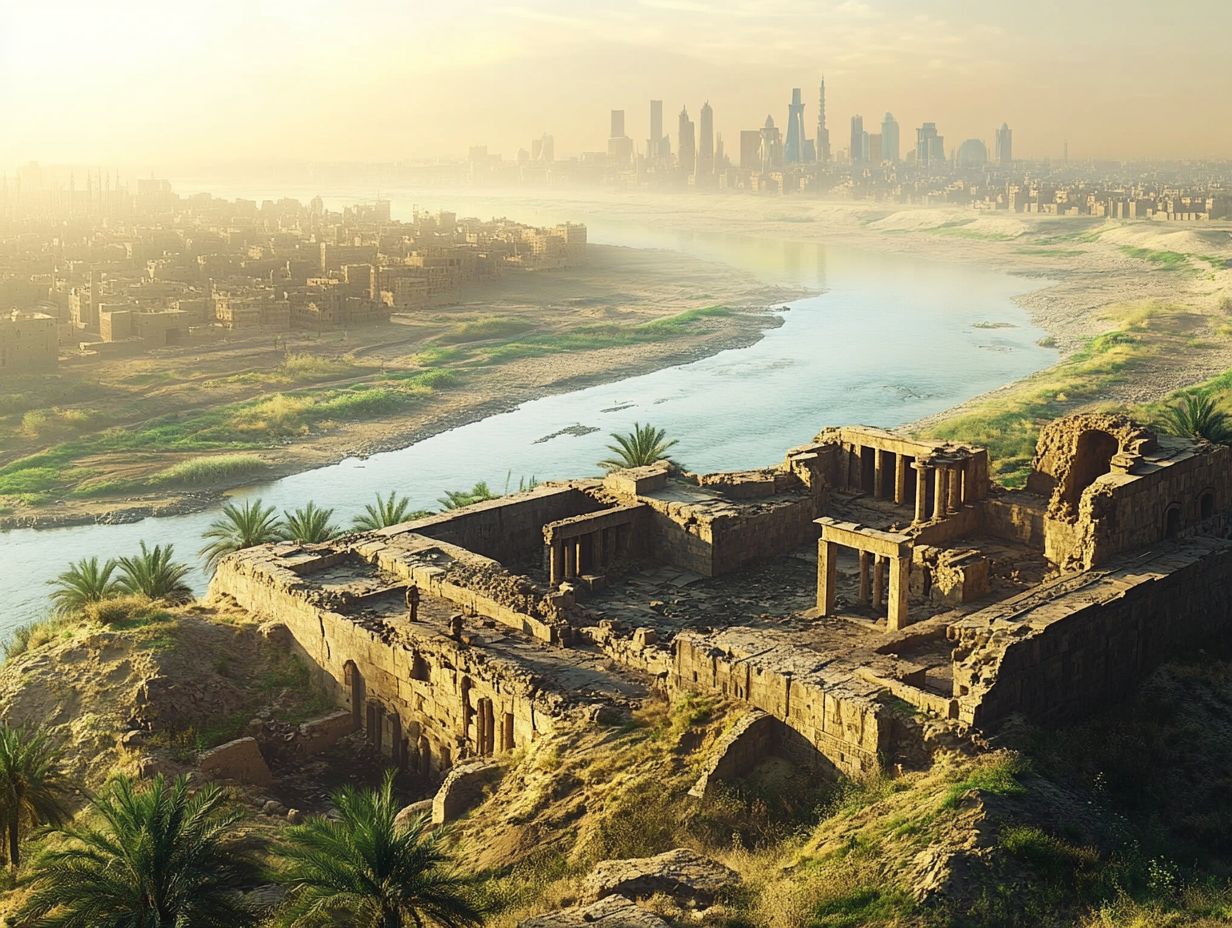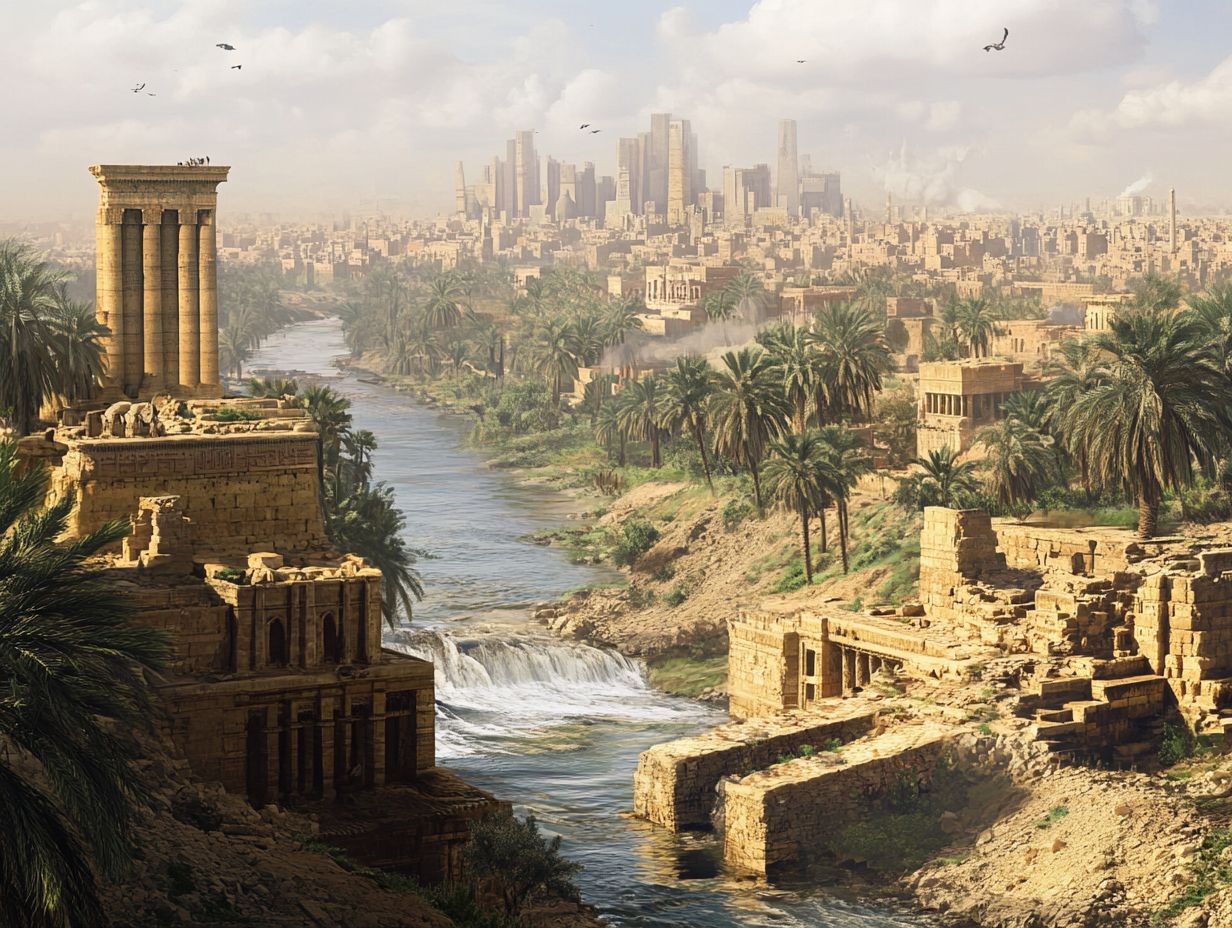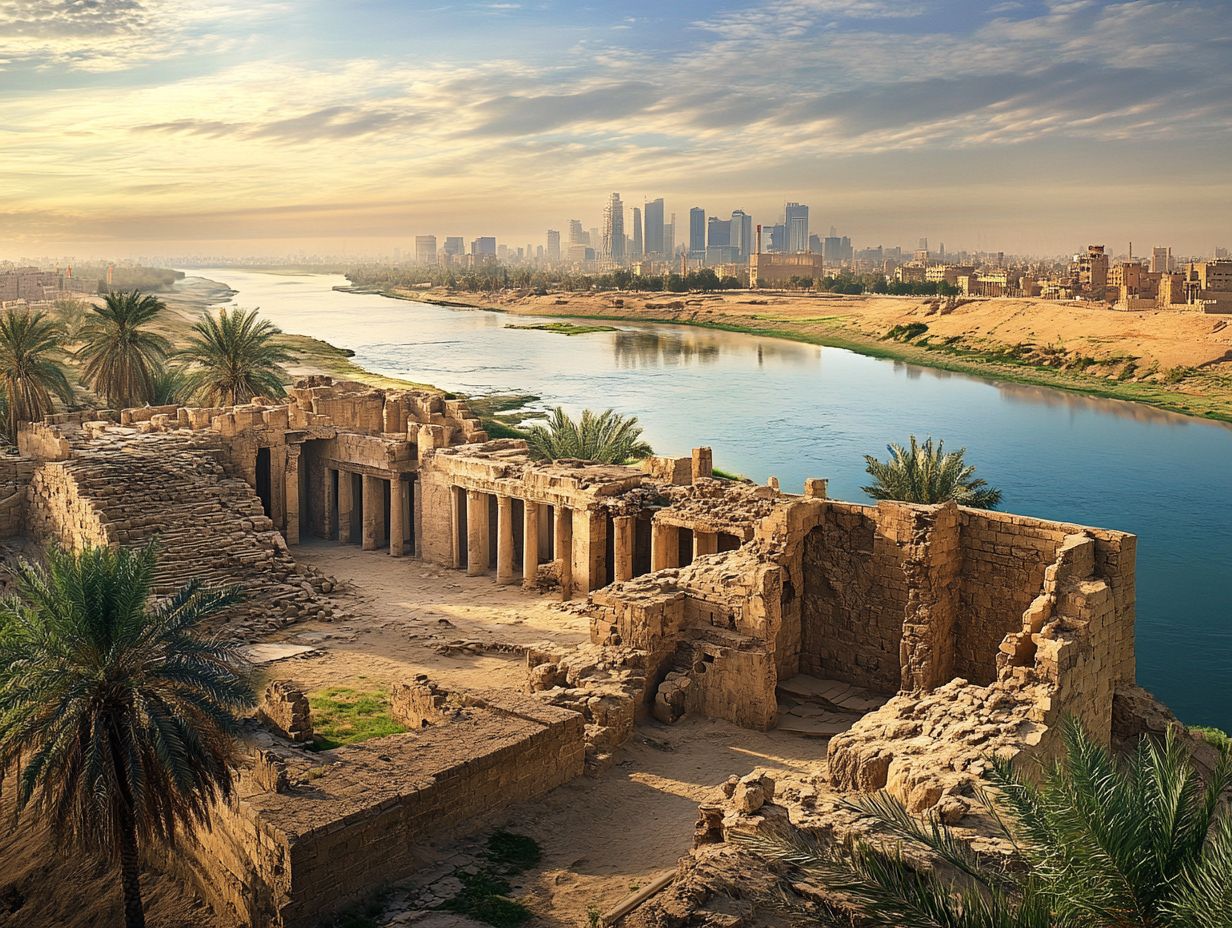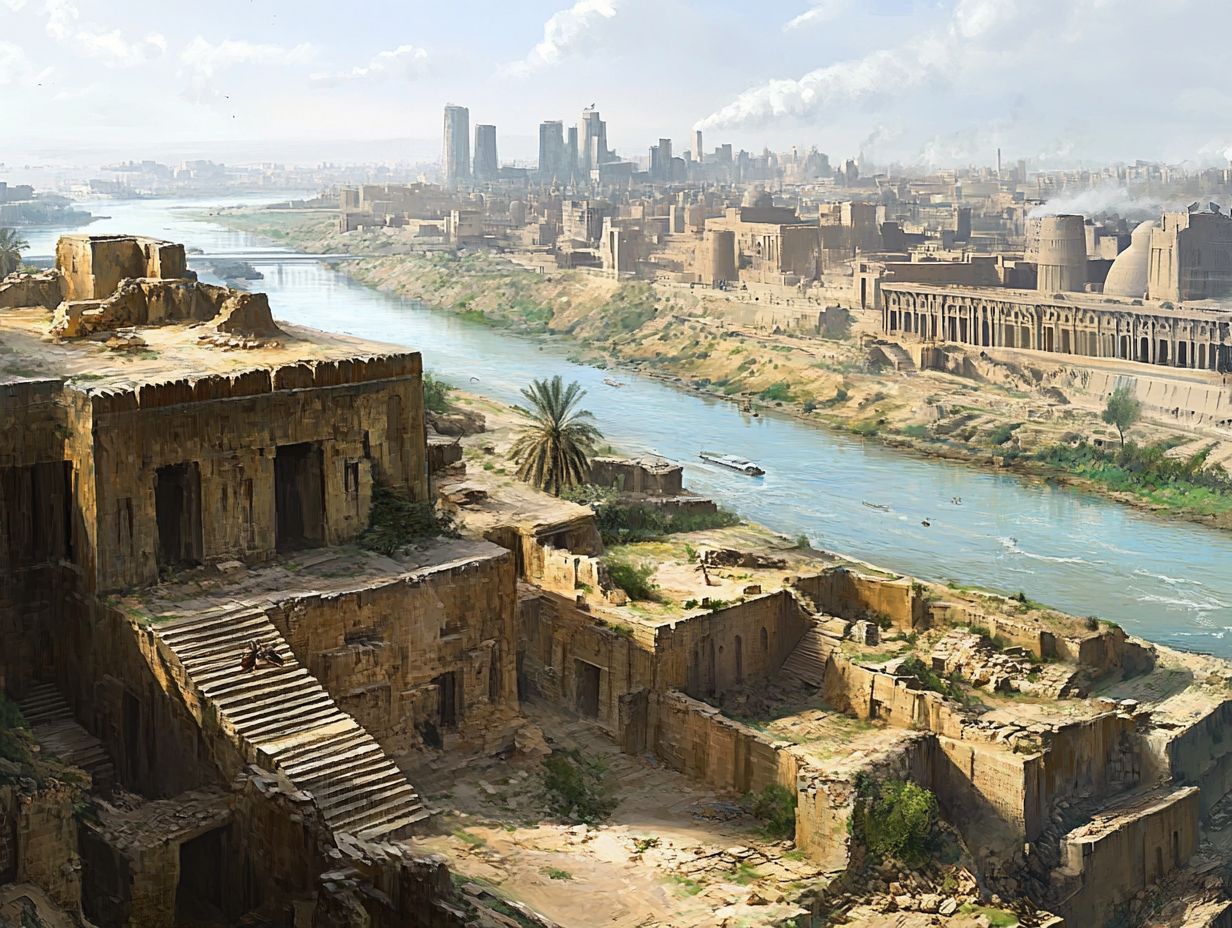
Definition and Importance
The History of Mesopotamia and Modern Iraq
Posted on August 24, 2024 in Politics
Mesopotamia, often hailed as the cradle of civilization, has left an indelible mark on human history.
Nestled between the Tigris and Euphrates rivers, this ancient region fostered groundbreaking advancements in agriculture, writing, and urbanization.
The rise and fall of its city-states, including Sumer, Akkad, Babylon, and Assyria, shaped the cultural and political landscapes of the time.
Today, modern Iraq stands as a testament to this rich heritage, intertwining the legacies of its past with contemporary identity.
Explore the fascinating journey from Mesopotamia’s origins to its influence on today’s world.
Definition and Importance

Mesopotamia, defined as the geographical region situated between the Tigris and Euphrates rivers, is recognized as one of the earliest cradles of civilization, profoundly influencing subsequent cultures and societies.
This area, often referred to as the “land between rivers,” played a crucial role in the development of urban life and the formation of states. It was in this region that the Sumerians, around 3000 BCE, pioneered significant innovations such as cuneiform writing, which not only facilitated record-keeping and trade but also established the foundation for literature and law.
The advancements in agriculture, mathematics, and astronomy originating from this region greatly influenced other ancient civilizations and provided a framework for future societies. Mesopotamia’s rich history illustrates how early human ingenuity has shaped the trajectory of human development and knowledge across the globe.
Geographical Context
The geographical context of Mesopotamia is characterized by its location between the Tigris and Euphrates rivers, which has played a crucial role in the agricultural development and societal evolution of the region. These two rivers, often referred to as the lifeblood of ancient civilization, provided essential irrigation that transformed a barren landscape into a fertile agricultural area.
This transformation enabled the early inhabitants to cultivate crops such as barley and wheat, resulting in food surpluses that ultimately supported the growth of larger communities. As settlements prospered along the banks of these rivers, they established complex trade networks that facilitated the exchange of goods and ideas, thereby laying the foundation for commerce in what is now modern Iraq.
Furthermore, the rivers not only influenced agricultural practices but also shaped cultural and political structures, leaving a lasting legacy that continues to resonate within the contemporary identity of the region.
Origins of Mesopotamian Civilization
The origins of Mesopotamian civilization can be traced to the development of early settlements, where advancements in agriculture and the organization of society provided a foundation for the establishment of complex political structures and a variety of cultures.
Early Settlements and Agriculture
Early settlements in Mesopotamia flourished due to the advancement of sophisticated agricultural practices, particularly innovative irrigation techniques that transformed the arid landscape into arable land. This transformation enabled communities to cultivate a diverse array of crops, including barley, wheat, and legumes, thereby supporting larger populations.
The effective management of water resources through the construction of canals and dikes not only enhanced crop yields but also established a foundation for the development of more complex societal structures. As these agricultural techniques progressed, the social hierarchy began to change, leading to the emergence of specialized roles within these communities, such as farmers, craftsmen, and traders.
The surplus generated from the fertile land promoted trade, facilitated the rise of urban centers, and spurred advancements in culture and governance, significantly influencing the trajectory of human civilization.
The Rise of City-States
The emergence of city-states in Mesopotamia represented a significant advancement in its political framework, with independent urban centers arising, each possessing its own governance and social hierarchy.
As these city-states evolved, they became the focal points of cultural and economic activity, characterized by a complex interplay of power, religion, and commerce. Each city-state, including prominent examples such as Ur, Uruk, and Babylon, operated under its own distinct set of laws and leadership structures, typically led by a king or a priest-king who wielded both political and spiritual authority. This form of governance facilitated the establishment of organized societies, wherein a clear social hierarchy was delineated, ranging from nobility to commoners and slaves.
Trade networks thrived as these centers engaged with one another and neighboring regions, facilitating the exchange of goods such as textiles, grains, and crafts. Notably, Babylon played a pivotal role in advancing legal and literary developments, exemplified by the Code of Hammurabi, which has left a lasting legacy on legal systems throughout history.
Key Historical Periods in Mesopotamia

The history of Mesopotamia can be systematically categorized into several significant historical periods, each marked by unique cultural, political, and technological developments. This timeline begins with the Sumerians, followed by the Akkadian Empire, the Babylonian state, and the Assyrian Empire.
Ancient Sumer: The Birth of Writing and Urbanization
Ancient Sumer, often recognized as the birthplace of writing, experienced remarkable urbanization and cultural development that established the groundwork for subsequent civilizations in Mesopotamia.
This early civilization witnessed the emergence of complex societal structures, characterized by the rise of city-states governed by influential leaders and priestly elites. Central to Sumerian innovation was cuneiform writing, a system that revolutionized communication, record-keeping, and the dissemination of knowledge. This method of inscribing wedge-shaped marks on clay tablets enabled the documentation of trade transactions, legal codes, and epic poetry, thereby exerting a profound influence on later cultures in the region.
The Sumerians’ advancements in agriculture, architecture, and legal frameworks not only propelled their society forward but also laid the foundation for future empires in Mesopotamia, such as the Akkadians and Babylonians, who subsequently built upon these foundational achievements.
The Akkadian Empire and Its Legacy
The Akkadian Empire, founded by Sargon of Akkad, represents a significant historical period in Mesopotamia, characterized by its expansion of influence and the enduring legacy it left on subsequent civilizations.
Under Sargon’s leadership, the empire implemented transformative political innovations, including the establishment of a centralized bureaucracy and the introduction of standardized weights and measures. These advancements facilitated trade and governance across extensive territories. The empire’s expansion encompassed substantial annexations of neighboring city-states and the creation of a comprehensive postal system that enhanced communication throughout the region.
Sargon’s military capabilities and strategic alliances were instrumental in consolidating power. The cultural impacts of the Akkadian Empire were profound, fostering advancements in art, literature, and law. These developments significantly shaped the governance structures of future civilizations and influenced Mesopotamian society for centuries.
The Babylonian Era: Hammurabi and Law
The Babylonian Era, particularly during the reign of Hammurabi, is highly regarded for its significant advancements in law and governance, exemplified by the Code of Hammurabi. This code established foundational legal principles that were integral to Mesopotamian society.
This monumental legal framework not only addressed aspects of civil and criminal justice but also provided a basis for social order, covering issues such as property rights, family matters, and trade regulations. The importance of Hammurabi’s rule extends beyond its immediate consequences; it established a foundation for future legal systems by underscoring the principles of justice and accountability.
Key historical sources, including clay tablets and inscriptions discovered in ancient ruins, offer valuable insights into this era. These artifacts illustrate how early laws served to unify diverse populations, promoting stability while influencing subsequent civilizations in their pursuit of effective governance.
The Assyrian Empire: Military Prowess and Expansion
The Assyrian Empire was distinguished by its remarkable military capabilities, strategic territorial expansion, and the establishment of a vast empire that encompassed prominent cities such as Nineveh, which exemplified the organizational expertise of Mesopotamian civilizations.
This extensive territory not only demonstrated their formidable strength in military engagements but also highlighted a sophisticated approach to governance and cultural development. The Assyrians instituted a well-structured administrative system that enabled efficient control over diverse regions. Along with their military achievements, they made noteworthy contributions to art and architecture, as evidenced by the grand palaces and intricate relief carvings found in Nineveh.
These advancements reflected the empire’s dedication to cultural progress, facilitating its economic and intellectual flourishing and thereby reinforcing its status as a significant power in the ancient world.
Religion and Culture in Mesopotamia

Religion and culture in Mesopotamia were intricately connected, characterized by a diverse pantheon of deities and a complex mythology that significantly influenced daily life and societal norms.
The Pantheon of Gods
The pantheon of gods in Mesopotamia was extensive, encompassing deities associated with various aspects of life, nature, and society, thereby reflecting the complex beliefs of ancient civilizations.
At the pinnacle of this pantheon was Anu, the sky god, who wielded supreme authority over the heavens. Enlil, the god of wind and storms, also played a critical role in both creation and destruction. Inanna, the goddess of love and war, represented the duality of passion and strength, significantly influencing societal norms and personal relationships.
Each deity served not only as an object of worship but also as a vital force shaping everyday life, inspiring rituals aimed at securing favor for agriculture, health, and prosperity. These divine figures were intricately woven into the fabric of daily existence, affecting various aspects of life, from agricultural practices to legal codes, thus underscoring the profound connection between religion and cultural identity in ancient Mesopotamia.
Mythology and Literature
Mesopotamian literature, particularly the Epic of Gilgamesh, exemplifies the rich mythology that has significantly influenced both the culture of the region and the broader literary tradition.
This ancient text serves as a valuable repository of storytelling, addressing themes such as friendship, the quest for immortality, and the intricacies of the human condition, all of which mirror the values and challenges of its time. Through the adventures of its protagonist, readers are offered insights into the societal values of courage, wisdom, and the inevitability of death, which are central to Mesopotamian culture.
The narrative employs a variety of storytelling techniques, including vivid imagery and symbolism, facilitating a comprehensive exploration of these timeless themes. Consequently, it underscores how such myths reflect the complex interplay between human aspirations and the natural world, functioning as a mirror to the historical contexts from which they originated.
Contributions to Science and Technology
The contributions of Mesopotamia to science and technology are substantial, including noteworthy advancements in mathematics, astronomy, and engineering that have significantly influenced the development of human knowledge.
Mathematics and Astronomy
The Mesopotamian civilization made significant contributions to mathematics and astronomy, establishing foundational principles for subsequent scientific exploration and understanding of the cosmos.
Their innovative development of a base-60 number system facilitated complex calculations and enabled the creation of advanced astronomical tables, which accurately predicted celestial events, including eclipses. Historical records, such as cuneiform inscriptions and clay tablets, illustrate how these ancient scholars meticulously documented their discoveries, adopting a systematic approach to observing and interpreting the night sky.
The importance of these early advancements cannot be overstated, as they not only influenced later cultures, such as the Greeks and Romans, but also laid the groundwork for essential methodologies in mathematical reasoning and astronomical research that continue to shape modern science.
Innovations in Agriculture and Engineering

Innovations in agriculture and engineering in Mesopotamia, particularly the development of advanced irrigation techniques, were essential for sustaining its urban centers and enhancing agricultural productivity.
These advancements enabled the transformation of arid landscapes into fertile farmland, allowing communities to cultivate a diverse array of crops, including barley, wheat, and legumes. The extensive implementation of canals, dikes, and reservoirs ensured a consistent water supply, even during the most arid seasons.
As agricultural yields increased, a surplus of produce became available, which not only nourished the expanding populations but also facilitated trade, thereby contributing to economic stability. This interconnection between agricultural prosperity and urban development highlighted the critical importance of engineering innovations, shaping a civilization that flourished through both industry and ingenuity.
Modern Iraq: A Historical Continuum
Modern Iraq embodies a historical continuum of Mesopotamian heritage, wherein the ancient legacies of civilization persist in their influence on contemporary culture and society, even amid the complexities of present-day challenges.
The Impact of Colonialism
The impact of colonialism on modern Iraq has been significant, fundamentally reshaping its political structure and cultural landscape while also posing challenges to the preservation of its Mesopotamian heritage.
The legacies of foreign domination have resulted in a complex web of social divisions, which often exacerbate ethnic and religious tensions that impede national unity. This fragmentation can be directly attributed to imposed borders and governance systems that fail to recognize the region’s rich diversity of cultures.
As Iraq confronts these historical challenges, the quest for cultural identity becomes increasingly essential. Efforts to revive and honor ancient Mesopotamian traditions and languages are critical, not only for a comprehensive understanding of Iraq’s historical roots but also for fostering a sense of belonging among its diverse population in the face of modern challenges.
The Role of Mesopotamian Heritage in Modern Identity
The role of Mesopotamian heritage in shaping modern Iraqi identity is of considerable significance, serving as a source of pride and cultural continuity amid the challenges faced by contemporary society.
This rich heritage is intricately woven into the fabric of daily life, manifesting in various forms—from the art of storytelling that evokes ancient myths to architectural styles that draw inspiration from the impressive ziggurats of the past.
Literature, particularly seminal works such as the Epic of Gilgamesh, continues to resonate profoundly, influencing modern poetry and narrative structures.
Traditional crafts, including pottery and weaving, frequently display motifs that reflect the intricate designs of ancient Mesopotamian civilizations.
Festival celebrations often incorporate elements that pay homage to ancient rituals, effectively bridging generations and reinforcing a profound connection to a remarkable historical legacy that continues to define and enrich the cultural identity of individuals residing in Iraq today.
Reflection on the Importance of Mesopotamian History
Reflecting on the significance of Mesopotamian history underscores its crucial role in shaping cultural influences and historical perspectives that persist in contemporary society.
The legacies established by the civilizations that thrived between the Tigris and Euphrates Rivers, including the Sumerians and Babylonians, provide valuable insights into governance, trade, and social organization. Their advancements in writing, mathematics, and law not only laid the groundwork for future societies but continue to inform modern practices and beliefs.
By investigating these early developments, individuals today can attain a more profound understanding of cultural intersections and the complexities of social dynamics. This historical context can enrich discussions surrounding contemporary issues, illustrating how historical experiences contribute to our collective identity and global interactions.
Future of Archaeological Efforts in Iraq
The future of archaeological endeavors in Iraq presents significant potential for revealing the rich tapestry of Mesopotamian cultural heritage and its historical sources, notwithstanding the challenges encountered.
This importance arises not only from the region’s status as one of the cradles of civilization but also from the invaluable insights it offers into early human societies, their innovations, and lifestyles.
A range of organizations, including international institutions and local initiatives, are actively engaged in efforts to protect these ancient sites while promoting their historical narratives. Training local archaeologists and implementing modern conservation techniques are critical components of these initiatives.
As investments in research and education continue to increase, the prospects for groundbreaking discoveries and a deeper understanding of Iraq’s historical identity appear more attainable than ever.
